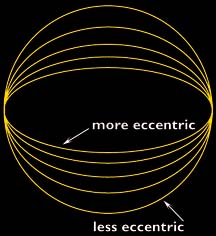This drawing illustrates "eccentricity".
Click on image for full size
Martian Orbital Eccentricity
The Martian climate is more influenced by the shape of the Martian orbit than the climate of the Earth is influenced by the shape of the Earth's orbit. The orbit of Mars is more oval-shaped than that of the Earth. The difference between the oval shape of the Martian orbit and a perfect circle is called the *eccentricity* of the orbit.
Because the Martian orbit has large differences in the distance from the sun, the surface of Mars can experience larger changes in temperature than does the Earth.
Changes in the inclination of the axis of revolution of Mars is also much more extreme than that of the Earth. This means that differences between summer and winter of Mars can be more extreme than on Earth.
The high eccentricity of the Martian orbit, combined with the high inclination of the axis of revolution, means that, if conditions are just right, there are times when Mars can experience a great deal more warming than normal. These extremes in the warming of the surface of Mars means that Mars has more potential for climate change brought about by orbit conditions than does the Earth.
You might also be interested in:
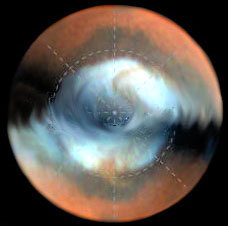
We have presented the fact that the atmosphere of Mars has very little water vapor so clouds don't form very easily. And we looked at the temperature, the fact that it is very cold almost everywhere in
...more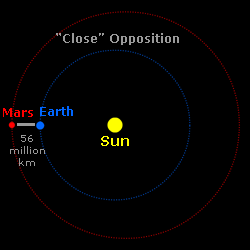
On August 27, 2003, Earth and Mars will be closer together than they have been in thousands of years. Mars will pass within 55,758,006 kilometers (34,646,418 miles) from Earth. Astronomers have calculated
...more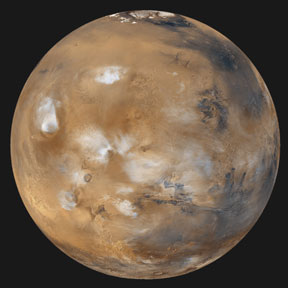
The planet Mars is closer to Earth than normal right now. On October 30, 2005, the two planets will be very close to each other. They will be about 69 million km (43 million miles) apart. Mars will look
...more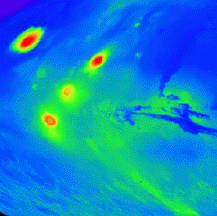
On this map of Mars, the lightly cratered Tharsis Ridge is shown, as well as the heavily cratered Martian highlands (near the bottom of the picture), and Valles Marineris to the right. The volcanoes are
...more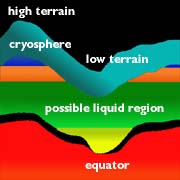
On Mars, the water is trapped, frozen, within the ground. Nevertheless, there is evidence for running water on Mars. When the water is melted and released to the surface, it will run from higher ground
...more
The drawing shows a crossection of the crust, and the unusual altitude variation of the Martian surface. The figure illustrates the depth of frozen ground at various latitudes, called the cryosphere. The
...more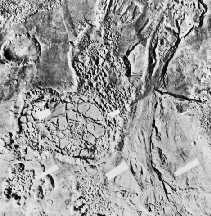
Separate from the Martian outflow channels, or the river valley networks, are large Martian lakes (600 km, or ~1000 miles across) which exhibit evidence of a periodic and catastrophic release of water
...more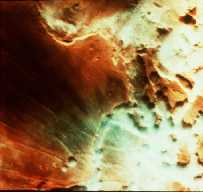
This is an image of fog in a Martian canyon. The presence of fog provides evidence of water, and a water cycle on Mars. More fog has been seen in images returned by Mars Global Surveyor of the south polar
...more


